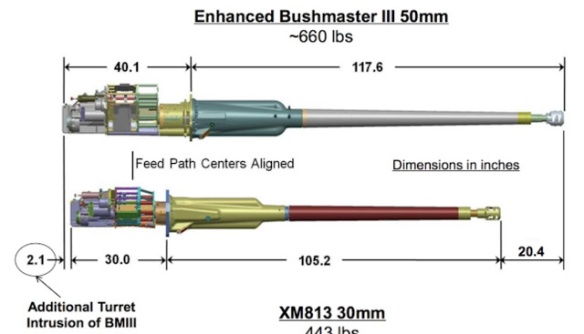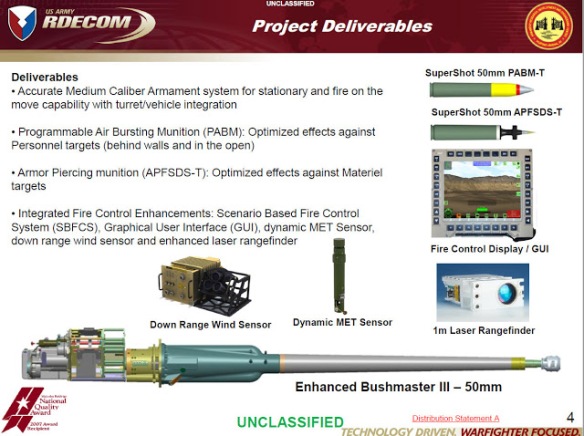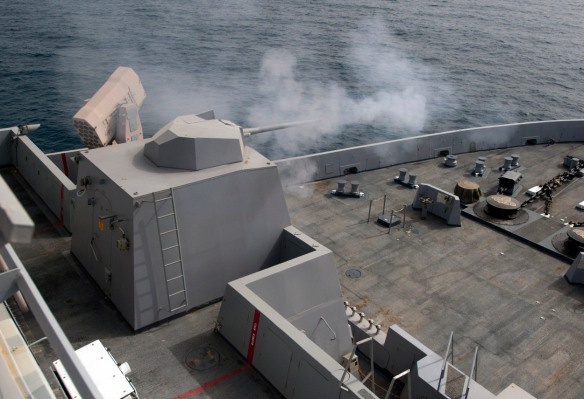Comparison of 50mm Bushmaster III with the 30mm Bushmaster II. By comparison the 25mm’s length over all is 105.2 in (2.672 m) and its barrel length is 85.6 in (2.175 m)
SNAFU has a discussion about what up-gunning Infantry Fighting Vehicles might mean to land warfare and included the graphical information above.
The dimensions provided give us some clues about the characteristics of the gun that were not available before. Length of the barrel in calibers (bore diameter) tells us something about the gun. You usually see it written as caliber/length in calibers, e.g. 5″/38 where 5″ is bore diameter and the barrel is 38 time 5″ in length. Length in calibers suggests other characteristics including muzzle velocity, time of flight, flatness of trajectory, accuracy, and penetration ability relative to other weapons of the same caliber. Greater length in calibers usually translates into higher muzzle velocity which imparts a flatter trajectory to a given range, which usually translates into greater accuracy and better penetration ability relative to other weapons of the same caliber. Larger caliber weapons might, and usually do, exceed these characteristics even using relatively shorter length calibers.
The Coast Guard uses or has used 5″/38s, 3″/50s, 76mm/62s, 57mm/70s, and 25mm/87s. In each case, greater length in calibers translated to higher muzzle velocities.
The barrel length for the 50mm indicated in the diagram above, 117.6″, translates to a length of 60 calibers, so we should expect a muzzle velocity similar to that of the 76mm/62 Mk75 (3,000 – 3,024 fps (914 – 925 mps)), perhaps slightly lower.
There are not a lot of contemporary weapons of similar characteristics. Perhaps the closest was a Soviet 45mm/78 anti-aircraft gun with a maximum ballistic range (firing at an elevation of 45 degrees) of 12,140 yards (11,100 m). Certainly the 50mm’s performance will exceed that of the Soviet 43mm/46 which had a max ballistic range of 10,060 yards (9,200 m).
On a more practical basis this probably means that, while the Army claims an effective range of 4000 meters (probably against another Infantry Fighting Vehicle), even without guided projectiles, it would start scoring hits against larger maritime targets at 7,000 yards, which was the maximum range we used to train 3″/50 crews for, using local control. In any case it would be able to engage from beyond 4000 yards which I believe would be the maximum effective range of any improvised armament available for use on even a terrorist vessel.
Looking at the two rounds mentioned above, Programable Air Burst Munition-tracer (PABM-T) and Armor Piercing Fin Stabilized Discarding Sabot-tracer (APFSDS-T).
- The APFSDS-T is probably going to have a better chance of disabling a large marine diesel engine than any weapon we currently have in service.
- The PABM-T should be effective against personnel in small fast highly maneuverable vessels and the programable feature means misses will detonate before going any great distance beyond the target, minimizing the possibility of collateral damage. It might also be effective against drones.
Thanks to Lee for pointing me to this information.



How would the 50mm stack up against the Mk110 57mm? Lighter and cheaper perhaps? Availability of armour piercing rounds?
Granted, the question is as much about the mount as about the gun.
There are certainly a lot of unanswered questions remaining. It is probably too much to hope for that it will fit in the Mk38. The recoil forces have to be much stronger than with the smaller weapons. We can be certain the 50mm will have an armor piercing round something the 57mm does not. On the other hand it appears the 57mm will have the ALaMO round, we don’t know about the 50mm.
As of 16 September 2020, ammunition available for the XM913 50x228mm is:
1. XM1203, APFSDS-T (Armor Piercing Fin Stabilized Discarding Sabot with Tracer
2. XM1204, HEAB-T (High Explosive Airburst with Tracer*
(*) XM1204, has programmable detonations with settings for PD (Point Detonate), PDD (Point Detonate Delay) and AB (Air Burst)
The XM913 is also capable of firing the 35x228mm Ammunition:
1. HEI (High Explosive Incendiary)
2. HEI-T (High Explosive Incendiary with Tracer)
3. SAPHEI-T (Semi-Armor Piercing High Explosive Incendiary with Tracer)
4. TP (Target Practice)
5. TP-T (Target Practice with Tracer)
6. AHEAD (Anti-Missile 152 Heavy Metal Sub-Projectiles)
7. ATOM 35 (Airburst Tungsten Heavy Pellets Sub-Projectiles)
…
@ Secundius
The XM913 is absolutely not capable of firing any 35mm ammunition at all. It has a 50mm barrel for christ’s sake. To fire 35mm ammunition it literally has to rebuilt as a Bushmaster III. You can not just simply swap out 35mm barrels
The 35/50 share the same Gun Breech design, with minor tweaking the 35x228mm/79.6-caliber barrel can be swapped out with the 50×228/59.7-caliber barrel. Paragraphs seven, eight, nine and ten…
( https://www.thedrive.com/the-war-zone/28310/need-a-50mm-cannon-for-your-bradley-fighting-vehicle-replacement-design-just-ask-the-army )
@ Secundius
I literally need to stop even engaging with you since you constantly prove to be stunningly ignorant.
Nothing in that article states that you can simply swap out barrels and change calibers.
Simply put, an XM913 is a 50mm cannon. Once you remove the entire weapon from it’s mount, disassemble it and replace numerous parts to enable it to be used as a 35mm cannon it is no longer an XM913. And let’s not forget that the fire control system must be reprogrammed, and the manual optical sights must be modified to accommodate the different ballistic characteristics of the different ammunition. And the automated ammunition feed system must be reconfigured to a different ammunition type selection.
But yeah, just swap the barrel.
It’s the SAME Gun Breech Sir, just with a different Barrel Caliber attached to it…
Which do you think is easier or less risky to develop…an armor piercing 57mm round or a guided 50mm projectile?
What the 50mm could have going for it is numbers, as in quantity. If the Army adopts the gun as standard for it’s IFVs, there will be a lot of these produced. This should drive down cost of both guns and ammo.
While this 50mm certainly looks promising and represents quite a leap over a 25mm, I’m still not convinced it’s the better road than just more widely deploying the 57mm. Perhaps if the 50mm were a drop-in replacement for the 25mm, a strong case could be made. Given the size of the gun, I’m sceptical that is the case.
The 50mm Bushmaster III stands little chance of being a “drop in replacement” for the Mk38 mounted 25mm M242 Bushmaster. The barrel of the 35mm Bushmaster III weighs almost as much as the M242. It is logical to assume the 50mm variant would weigh even more.
Given that the Navy chose to develop the Mk46 GWS to field the Mk44 30x173mm Bushmaster II, rather than using some modification to the Mk38, is probably further evidence that any surface vessel deployment if either caliber Bushmaster III will necessitate development of a new weapons station.
I would imagine that, aside from the size/weight/recoil factors, gun mounting choices will be greatly impacted by the space needed to stow a reasonable number of ammunition at the weapons station. And, the ability to feasibly move reloads to the weapons station.
@FDD,
I concur, but while the 57mm Mk110 definitely requires deck penetration and space below the mount, it seems more likely that there will be non-deck penetrating versions of the 50mm, or at least one that requires much less space, which would make it more easily adaptable to Coast Guard craft.
@Chuck

I think we have to remember that this is the non-deck penetrating 30mm Bushmaster II Mk46 GWS. (Which should likely be able to handle the 40mm upgun within it’s current space)
(from your own post)
You’re going to be hard pressed to drop that straight onto the deck of anything much smaller than an OPC.
And, something housing the 35/50 Bushmaster III will likely be bigger.
@FDD, actually the Mk46 mount does have a below deck component. See the last two photos on the post. First is a complete Gun Mission Module and then just the mount. https://chuckhillscgblog.net/2018/04/27/from-the-lcs-mission-modules-what-we-might-want-what-we-might-need/
Anything that can fit on an Infantry Fighting Vehicle that has to fit on public roads should also fit on a patrol boat, particularly if they grow the way I expect them to. https://chuckhillscgblog.net/2019/04/06/the-87-foot-wpb-replacement-an-addendum/
I am expecting a beam of about 7 meters. Even the 87 footers have a beam of almost 6 meters.
The Rafael Typhoon (on which the Mk 38 is based), can handle the 30mm Mk44 Bushmaster. Perhaps it can also handle the 40 x 180 variant with minimal or no modification?
@Malph,
Creating a real armor piercing round for the 57mm should be relatively easy, but I don’t think it is going to happen, because the Navy, which buys our ammunition, does not have a need for it. They don’t really see the 57mm as an anti-ship weapon. They have other systems for that. To them it is an anti-swarm weapon with a secondary anti-air capability. The ALaMO round answers the anti-swarm requirement. In the US having nothing larger than a medium caliber gun to forcibly stop even large ships is a uniquely Coast Guard problem, and, at least from what I have seen, the Navy does not procure weapons to solve uniquely Coast Guard problems. Internationally BAE/Bofors might be smart to develop a round to address that problem for coast guards all over the world.
I would not be unhappy to see 57mm Mk110s rather than 50mm on our WPB replacements. Either would be a huge leap in capability and the 57mm looks like it will be the better weapon against the small, fast, highly maneuverable end of the threat spectrum, at least until the 50mm gets a comparable guided projectile. It is just that it seems more likely that the 50mm will be made available for this class than the 57mm.
In any case, we also need something like Longbow Hellfire and hopefully light weight torpedoes to have a high probability of success. Actually I would put the missile ahead of the larger gun in terms of priority. That is, Hellfire and a 25mm would be preferable to a 50 or 57mm gun and no missile.
I’m a little surprised Bofors/BAE has not already developed an anti-ship penetrating round for the 57mm.
The US Navy expects to fight its enemies at distance using carrier air, submarines, …. as their principle anti-ship weapons.
Other users of the Bofors 57mm do not have that luxury. Nor does the CG. In Chuck’s rogue merchant ship scenario, it will be a come as you are affair and mostly like at fairly close range.
There is a quick-fix. Named NSM.
A Nice missile with a small formfactor
Should be able to fit in most vessels.
In Norway, a 47 meter vessel use the NSM, And Australia will use it on the Cape Class patrol boat ( 189 feet, 400 ton) But, you would probably put a missile like this on the larger vessels.
Above 500-600 tonns. I would guess.
Because you also need a good radar an ability to make a fire solution on a larger range. Like a 100 miles away.
There is also a request for a Helicopter version for the NSM missile. And then a possible Helicopter drone could in future use this from a larger coastguard cutter that has a Helipad. That could ad some more range, And suddenly you can target a vessel around 200 miles away. ( A few practical issues with that range, like a positive id, but in theory )
So, then you do not need a larger gun
Than a 57 mm Bofors with 3P rounds.
( some thinks )
I think, that the 76mm gun has some benefits, And there are new rounds for the 127mm gun that can give more range. Maybe we will se a 155mm or Even a 203mm gun in the future.
(8 inch gun)
New solutions, that increase range, might Just bring back the big gun’s.
We will have to w8 and see.
Malph, makes a good point, If the Army continues the 50mm development, they would absorb much of the upfront RST&E and other development costs. the Navy would have to develop or modify a suitable mount. Then the USN and USCG could be users.
It sounds like a win-win situation?
But of course, the USN Never like to use other services’ ordnance or but new guns~
There is some chance the Marines might use this which would put the guns and ammunition in the Navy system, but it seems more likely the Marines will use the 40mm version.
I can see the USMC selecting 40mm due to wider availability of rounds.
Ran across this additional piece indicating development of a guided 50mm round. It does look like this is old information and the project may not have gone anywhere.
https://www.revolvy.com/page/Bushmaster-III
“The U.S. Army is testing the Bushmaster 50 mm cannon as a counter rocket, artillery, and mortar (C-RAM) and counter unmanned aerial vehicle (C-UAV) weapon. Initially developed under the Extended Area Protection and Survivability Integrated Demonstration (EAPS ID), it has been successfully tested in tracking distant moving targets using interferometric radar as a sensor, fire control computer, and radio frequency transmitter and receiver to launch a course-correcting projectile. The command guided interceptors have a thruster that receives commands for maneuvering and warhead detonation, with a tantalum-tungsten alloy liner to form forward propelled penetrators to defeat C-RAM targets, and steel body fragments to destroy UAVs.[3][4] The systems can destroy UAVs at a range of 1 km (0.62 mi) and at a height of 1,500 m (4,900 ft).”
The EAPS rounds and he XM913 are not, I believe, compatible. My understanding is they had to lengthen the chamber quite a bit, and eventually went even bigger to a round that necked down to 50mm. It would be interesting to see if someone could put the guts of an EAPS rounds into a 57mm and how that would compare to ALAMO against those sorts of targets.
https://nationalinterest.org/blog/buzz/armys-next-generation-50mm-cannon-ready-destroy-109436
A little blurb on the new 50mm. Nothing mentioned about Naval applications but probably nothing to preclude it either.
I wonder about the weight of the mount needed for this admittedly impressive beast.
On the plus sides, if the Army does standardize on this gun, ammo development, parts and relative cost effectiveness due to numbers produced should all be (mostly) assured.
It appears that the Army will adapt this weapon. They have three contractors bidding to build the replacement for the Bradley Fighting Vehicle, but the 50 mm is specified as a requirement for all of them.
That is going to be a lot of vehicles and a lot of guns and ammunition.
I have been saying we need to be able to engage larger terrorist vessels from outside 4,000 yards to be able to avoid a hostile ability to target the weapons on our cutters. This would provide that ability while the 25 mm does not. If it could take an ALeMo round and elevate enough to take out air target, even if only UAVs with air burst/proximity rounds so much the better.
That is good news. We will need a good maritime oriented mount with good depth of magazine and elevation.
@Malph, re “We will need a good maritime oriented mount with good depth of magazine and elevation.” That is the real question, we have a better chance at that if the Marines also adopt the gun, but so far I have seen no indication of interest. They do seem to be interested in the 40 mm, but the 50 mm projectile is about twice as large as the 40 mm projectile.
Pingback: A New 30mm Round –Maybe a Reason to Upgrade the Mk38 Mounts | Chuck Hill's CG Blog
The Optionally Manned Fighting Vehicle competition that was to replace the Bradley Fighting Vehicle and was to have had the 50mm gun has been cancelled. The Army is still working toward some sort of replacement though. https://www.defensenews.com/land/2020/01/16/army-takes-step-back-on-bradley-replacement-prototyping-effort/
Army statement they are committed to replacing the Bradley, presumably still with a vehicle armed with the 50mm guns, but restarting the acquisition certainly will mean inevitable delays. https://breakingdefense.com/2020/01/army-fully-committed-to-replacing-the-bradley-gen-mcconville/
Someone really needs to develop a Naval mount for that 50mm.
Hopefully, something fairly lightweight, with little to no deck penetration and enough elevation to give the gun a chance against UAVs and other slow flying aircraft.
@Malph, my bet would be that we will see Israel develop a 50mm gun mount.
This is mostly about guns on infantry fighting vehicle, but the fact that the Russians are already going to a 57mm gun, it makes it much more likely the Army and perhaps the Marine Corps will go with at least a 50mm gun. (Thanks to Secundius for bringing this to my attention.)
https://euro-sd.com/2020/02/articles/16035/racing-towards-calibre-growth-medium-calibre-cannon-and-ammunition/
Continued development of the 50mm gun. https://www.janes.com/defence-news/news-detail/northrop-grumman-charges-on-with-xm913-50-mm-cannon-deliveries-to-us-army
Video update.
Updates on the 50mm and ammunition for 30mm and 50m, including the “swimmer” round. The remarkable news is that they are applying guidance to rounds as small as 20mm.
https://www.nationaldefensemagazine.org/articles/2020/10/9/army-upgrading-medium-caliber-cannons-ammo
Pingback: More on the New 50mm Chain Gun, and Maybe Counter-UAS | Chuck Hill's CG Blog
Pingback: Rheinmetall Millenium si... OMFV - Romania Military